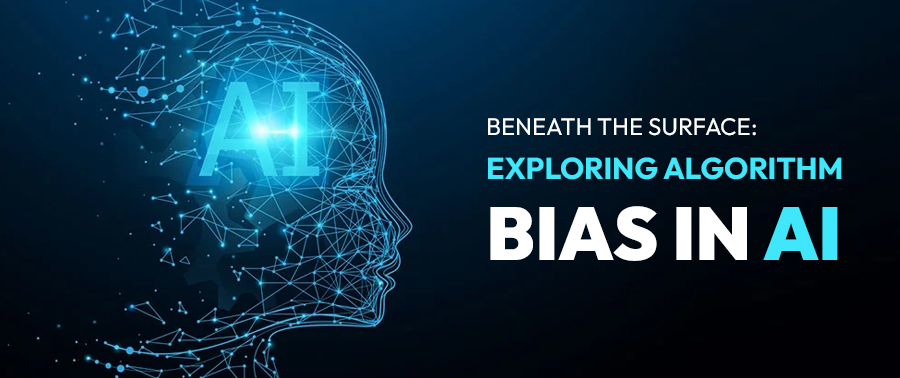In the age of Artificial Intelligence (AI), we’ve come to rely on algorithms to make decisions that shape our lives. Whether it is getting a loan approval or even being considered for a job interview, AI algorithms play a significant role.
However, with this increasing dependence on AI comes a pressing concern - Algorithm Bias. In this blog, we will look beyond what meets the eye in the realm of Algorithm Bias in AI, examining its various facets, including its real definition, root causes, detection methods, mitigation strategies, challenges in addressing it, and ultimately the steps to reduce its impact.
Understanding Algorithm Bias
Algorithm Bias, or AI bias, is the subtle yet significant presence of systematic and unfair discrimination within the outcomes generated by AI algorithms. These discriminatory outcomes can lead to unjust treatment or decisions based on various factors, including but not limited to race, gender, age, socioeconomic status, and more. Recognizing the presence of Algorithm Bias is the first step in addressing this complex issue.
Algorithm Bias often hides beneath the surface, invisible to the naked eye. It influences decisions that can affect a person's life trajectory, such as college admissions, job opportunities, or access to financial resources. These seemingly impartial algorithms can perpetuate and exacerbate societal inequalities.
Causes of Algorithm Bias
Data Bias - Biased training data is a leading cause of Algorithm Bias. When AI models are trained on data that reflects societal biases, they can inadvertently perpetuate these biases. For instance, if historical data shows a preference for one gender over another in hiring decisions, an AI model trained on such data may continue this bias.
Prejudiced Programming - Algorithm Bias can also be introduced during the programming phase. Developers, whether knowingly or unknowingly, may encode their own biases into the algorithms they create.
These biases can manifest in the form of skewed decision-making.
Incomplete Data - Algorithms can make biased assumptions when dealing with incomplete or unrepresentative data.
When AI models encounter gaps in information, they may fill these gaps with biased assumptions, leading to unfair outcomes.
Feedback Loops: Algorithm Bias can be exacerbated by feedback loops within AI systems.
When AI models continually interact with biased users or biased data sources, they can inadvertently reinforce and amplify existing biases over time, leading to a self-perpetuating cycle of bias.
Lack of Diversity in Development Teams: The composition of development teams can influence algorithm bias. When development teams lack diversity, they may not fully consider or understand the perspectives and experiences of underrepresented groups.
This can result in unintentional biases in algorithm design and decision-making processes.
Algorithm Bias Detection and Mitigation
Detecting Algorithm Bias is a crucial step in addressing this issue effectively. Several methods can be employed to identify and mitigate bias:
Data Auditing: Regularly audit and analyze training data for biases. Tools like IBM's AI Fairness 360 can help data scientists identify and address potential bias in their datasets.
Fairness Metrics: Implement fairness metrics to evaluate the performance of AI models across different demographic groups. Common metrics include disparate impact and equal opportunity difference.
Algorithmic Transparency: Enhance the transparency of your algorithms. Open-source AI models and clear documentation can help external auditors assess their fairness and accuracy.
Counterfactual Testing: Utilize counterfactual testing to assess how an AI system's decisions would change if certain variables, such as gender or race, were different. This method allows for the evaluation of whether the model's decisions are sensitive to sensitive attributes and provides insights into potential bias.
Bias Reporting Mechanisms: Implement mechanisms that allow users and stakeholders to report instances of bias or discrimination in AI systems. These reporting systems can help identify real-world instances of bias that may not be evident through data analysis alone, enabling organizations to take corrective actions promptly.
Mitigating Algorithm Bias requires a multi-pronged approach:
Balanced Data: Strive to collect diverse and representative data for training AI models. Augmenting underrepresented groups in the data can help reduce bias and ensure more equitable outcomes.
Regular Updates: Continuously update and retrain your AI models to adapt to changing societal norms and expectations. What may be considered biased today may not be so in the future.
Algorithm Adjustments: Implement corrective measures within algorithms to reduce bias. This may involve re-weighting the importance of certain features or data points, so they don't disproportionately influence outcomes.
Why is it Challenging to Address AI Bias?
Addressing AI Bias presents unique challenges:
Complex Algorithms: Many AI models, especially deep learning models, can be complex and difficult to interpret. This complexity makes bias detection and correction challenging, especially when algorithms are 'black boxes.'
Ethical Dilemmas: Striking a balance between fairness and accuracy can be ethically challenging. In some cases, striving for fairness may mean compromising on certain performance metrics, which can be a difficult decision for developers and organizations.
Data Availability: Obtaining diverse and unbiased data can be a significant challenge, especially when dealing with historically biased domains. Collecting comprehensive data can be resource-intensive and time-consuming.
Bias Amplification: In some instances, attempts to mitigate bias in AI systems can unintentionally lead to bias amplification. Adjusting algorithms to reduce bias in one area may inadvertently introduce bias in another, creating a complex trade-off between different forms of bias.
Lack of Standardization: The field of AI ethics and fairness is still evolving, and there is a lack of standardized guidelines and best practices for addressing bias. This makes it challenging for developers and organizations to navigate the landscape of AI fairness effectively, resulting in a lack of consistent approaches to mitigate bias.
Measures to Reduce AI Bias
While completely eradicating AI Bias may be an ambitious goal, there are several measures we can take to minimize its impact:
Diverse Teams: Encourage diversity within AI development teams. Diverse perspectives can help identify and rectify biases more effectively.
Ethical Guidelines: Develop and adhere to clear ethical guidelines for AI development. These guidelines can serve as a compass to navigate complex decisions and ensure that ethical considerations are at the forefront of AI development.
Algorithmic Fairness Tools: Leverage fairness tools and libraries to identify and rectify bias in AI models. These tools can help developers make more informed decisions and provide insights into potential bias within their models.
Regular Audits: Conduct regular audits of AI systems to ensure they remain free from bias and meet ethical standards. Regular checks and balances can help identify and address bias before it becomes a significant issue.
Public Accountability: Promote transparency and public accountability in AI development. Sharing information about AI development practices and decision-making processes with the public fosters trust and ensures that AI technologies benefit all of humanity.
Final Words
In the realm of Artificial Intelligence, the existence of Algorithm Bias is a compelling concern that demands our attention. It subtly infiltrates AI systems, shaping outcomes that impact our lives.
This comprehensive exploration of Algorithm Bias delves deep into its definition, root causes, detection, and mitigation methods. However, addressing this challenge is not without its hurdles, as the complexity of algorithms, ethical dilemmas, data limitations, and potential bias amplification present formidable obstacles.
Nevertheless, by embracing diversity, adhering to ethical guidelines, utilizing fairness tools, and fostering public accountability, we can embark on a journey toward reducing the impact of AI Bias and promoting equitable and fair AI systems for a better future.





Top comments (0)